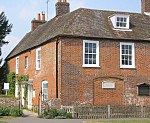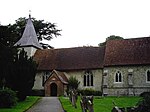Jane Austen's House Museum
1947 establishments in EnglandBiographical museums in HampshireGrade I listed buildings in HampshireGrade I listed housesGrade I listed museum buildings ... and 8 more
Historic house museums in HampshireHouses in HampshireLiterary museums in EnglandMuseums established in 1947Museums in HampshirePlaces associated with Jane AustenUse British English from February 2023Women's museums in the United Kingdom

Jane Austen's House Museum is a small independent museum in the village of Chawton near Alton in Hampshire. It is a writer's house museum occupying the 17th-century house (informally known as Chawton Cottage) in which novelist Jane Austen spent the last eight years of her life, during which time she wrote, revised and made ready to be published all six of her novels, and the fragment Sanditon. The museum has been a Grade I listed building since 1963.
Excerpt from the Wikipedia article Jane Austen's House Museum (License: CC BY-SA 3.0, Authors, Images).Jane Austen's House Museum
Winchester Road, East Hampshire Chawton
Geographical coordinates (GPS) Address Website External links Nearby Places Show on map
Geographical coordinates (GPS)
| Latitude | Longitude |
|---|---|
| N 51.1331 ° | E -0.989 ° |
Address
Jane Austen's House Museum
Winchester Road
GU34 1SD East Hampshire, Chawton
England, United Kingdom
Open on Google Maps








